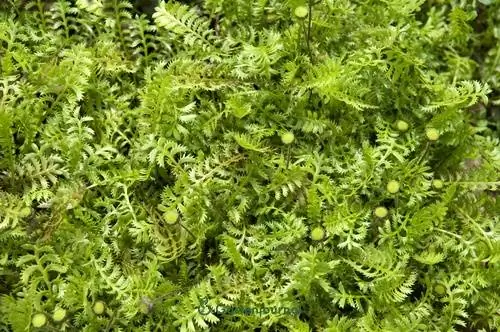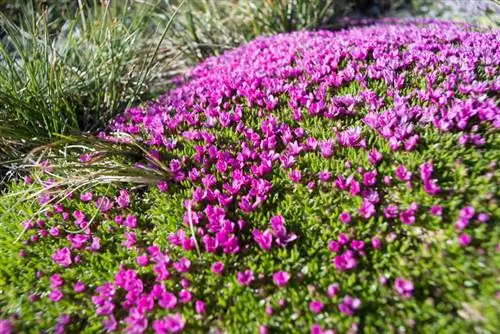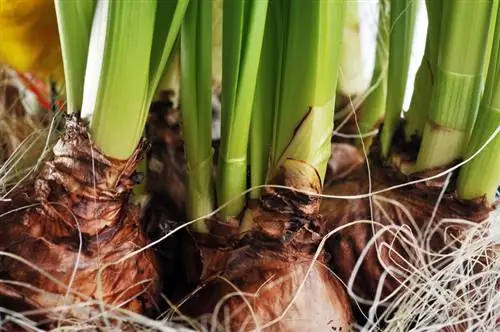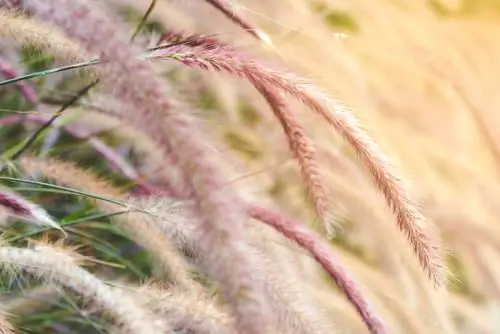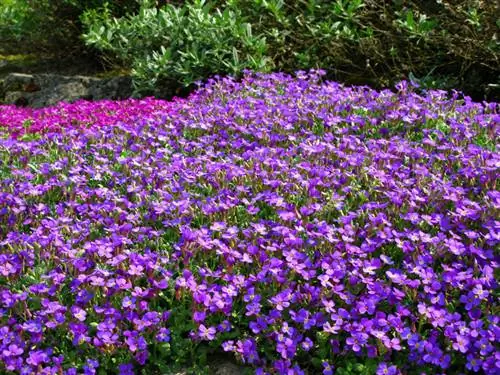- Author admin [email protected].
- Public 2023-12-16 16:46.
- Last modified 2025-01-23 11:21.
Feather cushions, also known as lye flowers, are a genus of carpet-forming cushion plants. The low-growing perennials are often planted as a lawn replacement and show numerous small, honey-scented flowers between June and August. The plant is also an attractive eye-catcher in the garden due to its seasonally changing colors. Read how to properly plant and care for the feather cushion - then you can enjoy this uncomplicated plant for a long time.
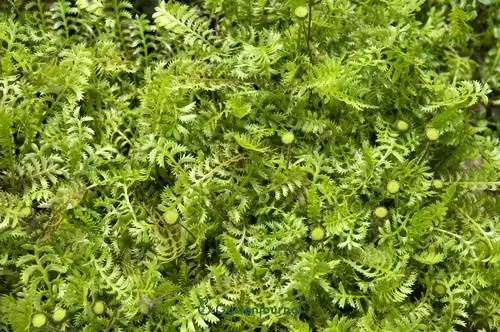
How do you care for feather pads in the garden?
The feather pad thrives in sunny to partially shaded locations with fresh to moist, well-drained soil. Light fertilization in spring promotes growth. Regular watering prevents drought damage and cutting measures are not necessary. Propagation occurs through division or runners.
Origin and distribution
The real feather cushion (bot. Cotula squalida, syn. Leptinella squalida), also simply called feather cushion, to distinguish it from other species of the genus brown feather cushion or lye flower, is a pretty, small and carpet-forming cushion perennial from the Asteraceae family (bot. Asteraceae). In addition to this species, the genus of plumage pads includes around 50 other varieties, which, with the exception of the crow's-foot lye flower (Cotula coronopifolia), which is now also naturalized here, are native exclusively to the southern hemisphere of the world. Cotula squalida is native to New Zealand, where it is widespread on both the North and South Islands. Here it is primarily at home in damp locations, for example on the edges of rivers and streams, on damp mountain meadows or in the lowlands near the coast.
Usage
The brown feather cushion is very suitable for moss gardens due to its low and mat-forming growth, but can also be planted as a robust lawn replacement. Planted in groups at a distance of ten to 30 centimeters, it quickly forms a soft cushioned carpet that can also be walked on to a certain extent. Furthermore, the small perennial is suitable for filling planting between sidewalk sections, stepping stones or under or between trees and smaller grasses. Since feather cushions prefer a rather moist substrate, the plants feel particularly comfortable at the edges of ponds or streams. But the perennials can also be used as large, permanently green plants in rock gardens or as grave plants.
In spring, the evergreen perennial comes into its own beautifully together with smaller bulb flowers such as wild tulips or crocuses. Otherwise, species such as fox-red sedge (bot. Carex buchananii) and other grasses, Carpathian cress (bot. Arabis procurrens), primroses (bot. Primula), ferns or hostas (bot. Hosta) are suitable planting partners.
Appearance and growth
Cotula squalida grows to a maximum height of five centimeters, but with its prostrate shoots it quickly forms dense, lawn-like mats. It owes its Latin name to the characteristic growth of its leaves, which is vaguely reminiscent of a bowl or bowl. The ancient Greek word kotyle means something like cup or bowl.
leaves
The delicate feather pad is cultivated primarily because of its elongated, brownish-green leaves. Due to their fine feathering, they are reminiscent of small ferns, although the daisy family is not related to them. Feather pads are usually winter or even evergreen.
Bloom and flowering time
The greenish-yellow, ball-shaped and up to two centimeters in diameter cup flowers of the plumage bloom between June and August. They are rather inconspicuous, but give off a pleasant scent of honey. The plants are very popular with bees and other butterflies, which is why they represent a valuable bee pasture in the natural garden.
Fruits
After the flowering period, the feather pad forms small, nut-like fruits, each containing only a single seed. Botanically, these fruits are also called achenes.
Toxicity
The feather pad is not poisonous to humans or animals.
Which location is suitable?
Cotula squalida feels most comfortable in a sunny or sunny to partially shaded location in the garden, which, however, must not dry out. Only the silver plumage, Cotula hispida, needs a place in full sun for he althy growth.
Floor
The real feather cushion feels most comfortable in fresh to moist, but well-drained and loose soil. If the subsoil is sufficiently moist, well ventilated and rich in nutrients, the small perennial quickly forms densely branched, even mats. However, the plant cannot tolerate waterlogging or drought at all. Ideally, the pH value of the soil is in the neutral range.
Planting feather pads correctly
If you want to use Cotula squalida as a ground cover or lawn replacement, plan around ten to 20 plants per square planting area, which are optimally planted ten to 30 centimeters apart - depending on the type and variety you choose. The best time to plant the vigorous feathery cushion is spring, so the perennial can grow well until next winter. Since Cotula species prefer moderately nutrient-rich, humus-rich soil, you should enrich poor soils with mature compost before planting and thus increase the nutrient content.
Watering and fertilizing
The easy-care feather pad grows quickly and easily in suitable locations, even without further care. A light fertilization before spring shoots with an organic fertilizer - mature compost, for example, is very suitable - helps the plant get started in the new growing season and ensures plenty of fresh, green foliage. On dry and warm summer days, additional watering may also be necessary to avoid drought damage. However, occasional drought does not harm the robust plant, even if it appears dried out and damaged: the perennial usually regenerates itself from the base with appropriate care.
Cut feather pads correctly
Basically, regular pruning is neither necessary nor useful; you should only carefully remove dried plant parts. The advantage of the feather pad as a lawn replacement in contrast to conventional grass is that the planting area does not have to be mowed or cut back.
Increase feather pads
Unlike many other flowering plants, the feather pad does not sow itself. In autumn you can collect the ripe fruits and sow the seeds directly on site or in a seedbed in early spring. However, this is usually not necessary as the perennial reproduces through numerous runners. This means that it forms the characteristic plant carpets after just a few weeks, but can also be easily propagated. To do this, simply separate some of the small runners and plant them separately. This procedure is also recommended if the growth of the feather pad should or must be limited.
Share
Another simple method of propagation is division, which is best done in spring. To do this, simply cut off flat pieces of the desired size with a sharp spade and reinsert them at the new location. Take this opportunity to remove diseased and dried parts of the plant so that the feather cushion also grows he althily in the new location. Immediately after replanting and in the weeks afterwards, you should water the planting area generously so that the new roots develop more quickly and there is no damage to the plant due to drought.
In contrast to other perennials, regular division of the feather pad for rejuvenation purposes is possible, but not necessary. The long-lived species does not tend to become bald and often only becomes dense and attractive with age.
Wintering
The feather pad has very good winter hardiness with a cold tolerance of up to minus 28 degrees Celsius. Nevertheless, sun protection against the glaring winter sun makes sense, especially when there is frost, as the perennial can react to the intensive irradiation by turning the leaves brown. Although this has no further negative effects on the plant, it does look unsightly. In addition, it will take a while next spring until the planted area appears fresh green again. As winter protection, a cover with brushwood is completely sufficient.
Diseases and pests
In general, the feather pad is quite resistant to pathogens and pests, but not completely insensitive. High levels of sunlight in particular can lead to problems in summer and winter, as an intensely sunny location often leads to brown leaf discoloration - this is especially true if the substrate is dry at the same time. However, regular watering and, if necessary, shading, especially around midday, will allow the plant to recover quickly. If bright spots are visible in the plant mats in summer, spider mites have often found their way there. The annoying pests occur particularly frequently in dry years and damage the plants through their sucking activities.
Snail feeding is also problematic, and it is not just the appetite of the crawling pests that harms the plants: the slimy secretions also ensure that the planted areas are blocked from air, which in turn can lead to rot. To prevent this, effective snail barriers (€9.00 on Amazon) should be installed. Furthermore, in the event of an infestation, small twigs and leaves should be removed to ensure ventilation of the mats.
Tip
If you are looking for a suitable lawn replacement, there are other types of perennials in addition to the feathery cushion, which is suitable for more shady and damp locations. Carpet thyme, for example, fits well in sunny locations; stonecrop or prickly nut is recommended for dry and sunny locations. The uncomplicated star moss (bot. Sagina subulata), which also thrives in sunnier places, is not only popular in Japanese gardens. Roman chamomile, on the other hand, can be used well as a fragrant lawn.
Species and varieties
In addition to the actual species Cotula squalida, only the variety 'Platt's Black' is available commercially, but it lives up to its name. In contrast to the wild species, the perennial, which also only grows to a height of five centimeters, has strikingly dark leaflets that are reddish-brown in summer and black-green in winter. In addition to the real or brown feather pad, there are also various types available that can also be used very well in the garden and are quite similar to the type described here in terms of their requirements in terms of location and care.
Cinquefoil feather carpet (bot. Cotula potentillina)
This variety, which also comes from New Zealand, has very similar characteristics to Cotula squalida in terms of growth and properties, but is slightly taller with a height of up to ten centimeters.
Dull green feather pad (bot. Cotula diotica)
This species forms lush carpets of leaflets that are green in summer and copper-colored in winter. The plants, which only grow up to five centimeters high, bloom quite early compared to related species: the small, light yellow flower heads appear between May and June. In addition to the already short-growing species, there is a dwarf variety called 'Minima'. This only grows to three centimeters high.
Silver plumage pad (bot. Cotula hispida)
In contrast to the other Cotula species, this one requires a sunny location with a rather poor substrate. The silvery perennial produces yellow flower heads between May and July and can grow up to ten centimeters high.

